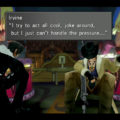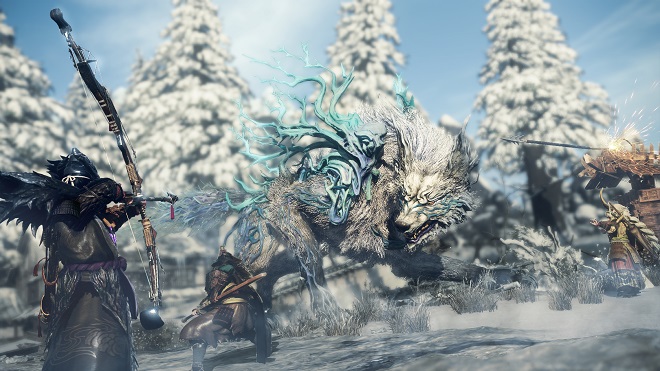Quarantine Control #130: Easy, Tiger

There’s news about COVID cases rising yet again despite previous hopes regarding a new booster and the death count previously dropping. But have you heard about it? Probably not, for several good reasons. It’s getting overshadowed by all the other horrendous news, largely pertaining to Hurricane Ian wreaking havoc on Cuba and the Southeastern United States and new horrifying developments about the war in Ukraine. With all this bad news, it’s tempting to ignore it all and lay low for a while, yet it’s also necessary to stay informed. Quite a dilemma.
Geoffrey Barnes
Ys VIII: Lacrimosa of Dana (2016)
Source: Nintendo Switch (also on Vita, PS4, PC, and soon PS5)
Episodes: 1 video game

It was Ys Seven that put Falcom’s classic Ys series on an alternative path. Instead of making another solo game starring Adol Christin like the older, now “classic,” games, or another title with characters who fight solo like Ys Origin, the developers went ahead and strapped Adol to a party. It was fun, a way to further emphasize the “RPG” in the “action RPG” genre the games occupy, but it came with unfortunate sacrifices. Some came in the form of Adol himself, who had to stick with utilizing swords while leaving the usage of other weapons and magic to other characters to encourage switching between them. The biggest difference was the reduction of platforming with jumping being replaced by dashing, which hindered the possibilities of the levels the developers could make and made traversing more of a hassle than it should have been. This continued with Ys: Memories of Celceta, the remake (more a reimagining) of Ys IV.
It’s good that Falcom listened to the player base with some criticisms, because they made Ys VIII: Lacrimosa of Dana considerably more polished than prior games while keeping the parties. There are a few stumbles, however.
The story begins familiarly by Ys standards, with Adol Christin and best friend forever Dogi being on a ship following the events of Ys V. But the ship comes across a location known as the Isle of Seiren, one known for being the final destination of many ships thanks to an apparent curse. You will never guess what happens here: Gigantic monsters wreck the ship, leaving a small amount of characters stranded on the island. The game’s story is about finding all the shipwrecked members of the Lombardia. Shipwrecks are extremely common for Adol by this point. If I was in an Ys game and I heard a guy named “Adol Christin” was on a ship with me, I would simply not be on there.
The trek to find all the shipwrecked travelers and crew on the Lombardia and explore the Isle of Seiren is just as arduous as it sounds — for the characters, anyway, even though Adol is used to this stuff by now. It’s fun for the player, however. In addition to delivering the combat and exploration through forests and several dungeons expected from an action RPG of this type, with jumping and platforming returning this time, there are all sorts of location points, treasures, and horrifying enemies in addition to the shipwrecked people. Some join the party, but most others take up jobs at Castaway Village. It’s Lost: Anime Edition.
Again, the game itself is good fun, with a challenge that never lets up on the normal difficulty. How difficult the game is depends on how quickly the player can adjust to the fully 3D camera (forgoing the isometric one from previous games) and master Flash Moving and Flash Guarding. The former involves dodging just before an enemy hit lands, which slows down time to allow for the characters to wallop the enemies. The latter involves blocking attacks just before they land, which increases attack power for a few seconds. It’s not easy to do, especially for someone who insisted on playing the Switch version like me, which runs at half the framerate and makes it tougher to time dodging and blocking. But it adds a unique dynamic to the combat by providing good rewards for good play.
I didn’t have much of an issue with the game not being a looker, knowing full well that it was originally made for Vita and was handled by a small developer. It’s unfortunate that the Switch version’s framerate runs at 30fps instead of 60fps like the PS4 and PC versions, but even that was easy enough to adjust to after a while. I never adjusted to just how overly wordy the game was, though. Plenty of Japanese RPGs have superfluous text in conversations that don’t need to go as long as they need to. Ys Seven had the same issue; the developers remarkably doubled down on that here. The combination of this, and how the story sometimes restricts players from using fast travel for very minor plot-related reasons, lead to the game being longer than it has to be.
Fortunately, none of those issues prevent Ys VIII from being one of the best action RPGs around. But it helps to know what you’re getting into before starting. I’m so late to the party here that it’s now been over a year since the localization of Ys IX was released, and Ys X is now on the horizon. Fortunately, there are long-enough gaps in the release schedules for me to catch up, and that’s not even considering the long, old school-style localization times these games still have.
Joseph Daniels
Hey, Fraser Lake? Can you maybe fix your power grid so that it’s not so fucking fragile? The power’s gone out more times this year than I ever remember in Revelstoke. It wouldn’t be so bad, but having to reboot devices that I was trying to use, like my PlayStation 4, is frustrating. Add to that the fact that your games don’t care if you didn’t know you were going to lose power. I’ve been denied credit for PVP wins that I was well on my way to getting due to power failures, and trying to get my damn Frontline win percentage up past 30% is pain and misery and suffering as it is. Maybe someday I’ll rant about the early days, when the meta was basically to shit all over my team so that it’d always get third place, since for some reason I “chose wrong” when picking my Grand Company long before the Frontline mode of PVP was ever invented. I’ve been struggling to get some semblance of a normal spread of lifetime wins, second place finishes and outright losses ever since, so it doesn’t help when I’m about to score another win and the power goes out. This wouldn’t be so bad, except that even though it sometimes doesn’t count the result of the match if the power goes out, it still counts as another match entered, and so all three percentages, even my wins, take a hit. I don’t know if I’m getting kicked from the party by my team or if the game just sometimes doesn’t count your win if you’re not online to get it, but I’m getting tired of struggling to get wins, only to have them yanked away from me by Fraser Lake’s fragile power grid.
I’m just glad it didn’t go out when I was trying to watch the following movie, because I might’ve just decided not to finish it.
The Tiger Rising (2022)
Source: Netflix
Tiger Representation: The absolutely creatively named tiger, “The Tiger”

I wonder if the movie was going for some kind of subtle magical realism in this plot of a boy who’s good at sculpting, a brash tiger of a girl who befriends him, and the actual tiger they find out in the woods in a cage. I’ve not read the book, and it’s funny that I didn’t even know it was a book until I read the end credits, but throughout the movie, it felt like the characters were delivering book dialogue. Like, they do know that no one talks like that, right? But anyway, at various parts of the movie, Rob (the boy sculptor) saw his creations come to life for a moment and even reacted to them. A tiger drawing on a page, the sculpture of his friend Sistine, a bird sculpture he eventually gave to an adult he befriended named Willie May, everything came to life for a moment in his hands.
Throughout the movie, we also saw glimpses of the past, of Rob’s happier family when his mother was still alive, as part of the movie’s plot involved his father trying to come to grips with her death. If anything, the titular tiger didn’t have much screen time despite being what the movie was supposed to be about.
The Tiger Rising felt like one of those stories that they give to students to read and then expect them to write a book report about, because young children usually won’t come up with anything truly nuanced about anything. If a student is paying attention, they’ll likely notice parallels between Sistine and the tiger – the tiger has no name, because his owner refused to give it one – and mentioning such would likely give the student an easy B at the very least. Talk about the Sistine Chapel a bit, maybe talk about cages for a bit, and you have an A-grade report that the teacher will likely only skim because he or she will have read hundreds of them by that point and they’re really only looking to see if the student has shown a cursory understanding of the book.
I don’t think there was a single book that I had to read for school, other than To Kill A Mockingbird, that I liked, and even then, I might not have chosen to read it because it was outside of my usual taste in literature. There are books that are supposedly important and influential and “literary”, whatever that means, that are utterly boring to read. They’re not my taste in book. If they wanted us to be more engaged with English class, we should’ve been allowed to pick our own books to read.
It’s surprising that The Tiger Rising came from the same writer as books like The Tale of Despereaux, an adventure story about a mouse who wanted to be a hero. It felt like the movie for Despereaux was more complete than for the Tiger. Either that or I didn’t pick up on very many subtleties of the plot. Here’s the thing: there were bullies who never got what was coming to them, and we didn’t ever get the sense that things would be better for Rob at school at any point in the story, even at the end. It’s true that Rob’s father finally decided it was time to properly grieve for his wife, and Sistine finally stopped stubbornly believing her father was going to come and rescue her from her mother, and it felt a little like the story might actually have been about the people around Rob who were a part of his life. However, there was an art teacher who showed interest in him and arrived on camera twice to try to shove her way into the plot, only to be jettisoned just as quickly, as if she were some extra who kept on trying to crash the set and they left a couple of her scenes in. There was also a school principal who didn’t do much either except to request that Rob should stay home for a bit, which he suggested while he fiddled with his really bad combover.
For all I know, these characters were also in the book, but when adapting a book into a movie, it’s perfectly acceptable to change things a bit if there are parts of the story that could be streamlined. The original animated film for The Hundred and One Dalmatians was a well written, tight narrative that cut out a couple of the adult dogs, removed the gypsies entirely from the plot, and even removed Cruella’s cat and her husband. All of these cuts were to tighten the narrative and not waste time on characters that the animated film didn’t have any need for. Scenes like Cruella showing delight at someone’s home burning down were cut, and others during the dalmatians’ journey home were changed to include her where she had previously only been literal background noise. There were other changes, but this article is supposed to be about The Tiger Rising, so I’ll stop digressing.
Throughout the film, Rob was scratching at his legs, due to the disease that he was getting treated for. What disease? The movie didn’t say, and it made me wonder if the book said what it was or if it, too, remained vague about it. It felt a little like the author, Kate DiCamillo, didn’t want to actually come up with names for everything, so she left the tiger blank and also gave Rob some unnamed illness that acted as an excuse for him to not be in school for most of the story. The disease caused Rob to scratch at his skin a lot, but it was not contagious, which led me to one easy conclusion. It’s okay, Kate, you can use words like eczema in your novels. If anything, it’ll teach children a new word and then maybe the quality of small town spelling bees will be slightly improved. Rob’s eczema didn’t do much for the plot except give him an excuse to be doing stuff around the hotel he and his father were living at.
That’s how the movie felt. Like a chain of excuses to keep the plot moving. Like, for example, it was clever of Rob to pretend that he’d never seen the tiger before when its owner decided to hire Rob to feed it, but at the same time, there was nothing in the scene to indicate that Rob was pretending, and the scene only served as an excuse to give him the keys to the tiger’s cage, in anticipation of the end of the film.
In the end, the tiger only felt incidental to the plot, and at the risk of spoiling things, I will say this: it’s 2022 and yet it felt like the movie was written in 1963. If you don’t understand what I mean, watch the film and then read last week’s Quarantine Control.
It’s a bad and sad world out there, so all that can be said here is to stay as safe as you can. Just don’t think about how much worse things could get. Oh wait, this isn’t helping. What a way to celebrate the 130th Quarantine Control entry, though it’s fitting considering that this feature started thanks to a pandemic that’s killed well over a million people. Until next week.





